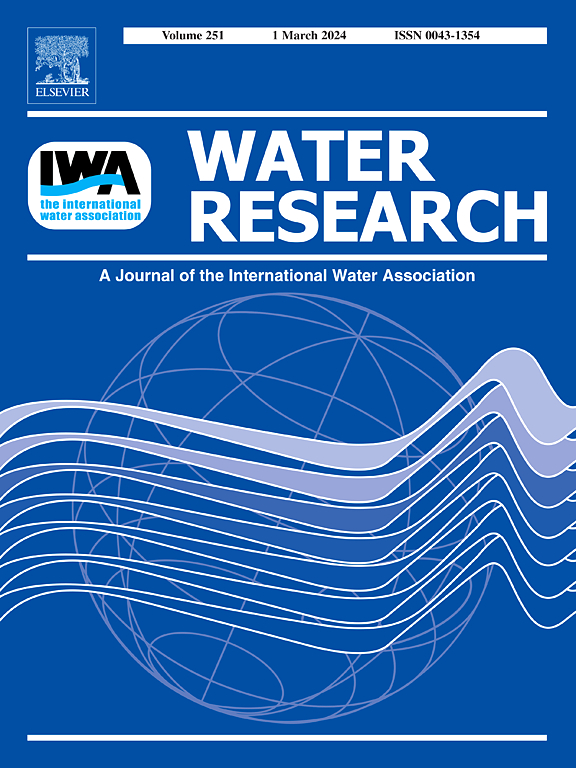Hydrophilicity-dependent photodegradation of antibiotics in ice: Freeze-concentration effects and dissolved organic matter interactions drive divergent kinetics, pathways and toxicity
IF 12.4
1区 环境科学与生态学
Q1 ENGINEERING, ENVIRONMENTAL
引用次数: 0
Abstract
The photodegradation behavior of antibiotics with different hydrophilicity in ice and the synergistic effect of dissolved organic matter (DOM) remains unclear. This study unravels the dual role of DOM in driving divergent photodegradation pathways for five antibiotics (sulfamethoxazole (SMZ), oxytetracycline (OTC), levofloxacin (LFX), ciprofloxacin (CIP), and norfloxacin (NOR)) with different hydrophilicity in ice and compares the outcomes with a similar treatment in aqueous systems under simulated sunlight. The results showed that the photodegradation of hydrophilic antibiotics (SMZ, OTC, LFX) in ice is faster compared to water, which attributed to freeze-concentration effects that enhance light absorption in ice’s liquid-like regions (LLRs). Conversely, hydrophobic antibiotics (CIP, NOR) degraded faster in water due to solvent cage effects. DOM amplified the photodegradation of hydrophilic antibiotics in ice by enriching humic-like substances in LLRs, which generated more reactive singlet oxygen (e.g. 77.1 % contribution to SMZ degradation), while inhibited the photodegradation of hydrophobic antibiotic via protein-like substances that quench excited states. Notably, DOM introduced ice-specific oxidative pathways of hydrophilic antibiotics, which altered their toxicity profiles and complicated toxicity trends toward Vibrio fischeri. These findings highlight the critical role of ice-phase photochemistry in cold regions, influencing antibiotic fate, transformation pathways, and ecological risks.


抗生素在冰中亲水性依赖的光降解:冷冻浓度效应和溶解有机物相互作用驱动不同的动力学、途径和毒性
不同亲水性抗生素在冰中的光降解行为及溶解有机物(DOM)的协同作用尚不清楚。本研究揭示了DOM在驱动五种不同亲水性抗生素(磺胺甲新唑(SMZ)、土霉素(OTC)、左氧氟沙星(LFX)、环丙沙星(CIP)和诺氟沙星(NOR))在冰上不同光降解途径中的双重作用,并将其与模拟阳光下水系统中类似处理的结果进行了比较。结果表明,亲水抗生素(SMZ, OTC, LFX)在冰中的光降解速度比在水中更快,这是由于冻结浓度效应增强了冰的液体状区域(llr)的光吸收。相反,由于溶剂笼效应,疏水性抗生素(CIP, NOR)在水中降解更快。DOM通过在llr中富集腐殖质样物质,增强了亲水性抗生素在冰中的光降解,产生了更多活性单线态氧(例如,对SMZ降解的贡献为77.1%),同时通过蛋白质样物质抑制了疏水抗生素的光降解,猝灭激发态。值得注意的是,DOM引入了亲水抗生素的冰特异性氧化途径,改变了它们对费氏弧菌的毒性特征和复杂的毒性趋势。这些发现强调了冰相光化学在寒冷地区的关键作用,影响抗生素的命运、转化途径和生态风险。
本文章由计算机程序翻译,如有差异,请以英文原文为准。
求助全文
约1分钟内获得全文
求助全文
来源期刊

Water Research
环境科学-工程:环境
CiteScore
20.80
自引率
9.40%
发文量
1307
审稿时长
38 days
期刊介绍:
Water Research, along with its open access companion journal Water Research X, serves as a platform for publishing original research papers covering various aspects of the science and technology related to the anthropogenic water cycle, water quality, and its management worldwide. The audience targeted by the journal comprises biologists, chemical engineers, chemists, civil engineers, environmental engineers, limnologists, and microbiologists. The scope of the journal include:
•Treatment processes for water and wastewaters (municipal, agricultural, industrial, and on-site treatment), including resource recovery and residuals management;
•Urban hydrology including sewer systems, stormwater management, and green infrastructure;
•Drinking water treatment and distribution;
•Potable and non-potable water reuse;
•Sanitation, public health, and risk assessment;
•Anaerobic digestion, solid and hazardous waste management, including source characterization and the effects and control of leachates and gaseous emissions;
•Contaminants (chemical, microbial, anthropogenic particles such as nanoparticles or microplastics) and related water quality sensing, monitoring, fate, and assessment;
•Anthropogenic impacts on inland, tidal, coastal and urban waters, focusing on surface and ground waters, and point and non-point sources of pollution;
•Environmental restoration, linked to surface water, groundwater and groundwater remediation;
•Analysis of the interfaces between sediments and water, and between water and atmosphere, focusing specifically on anthropogenic impacts;
•Mathematical modelling, systems analysis, machine learning, and beneficial use of big data related to the anthropogenic water cycle;
•Socio-economic, policy, and regulations studies.
 求助内容:
求助内容: 应助结果提醒方式:
应助结果提醒方式:


